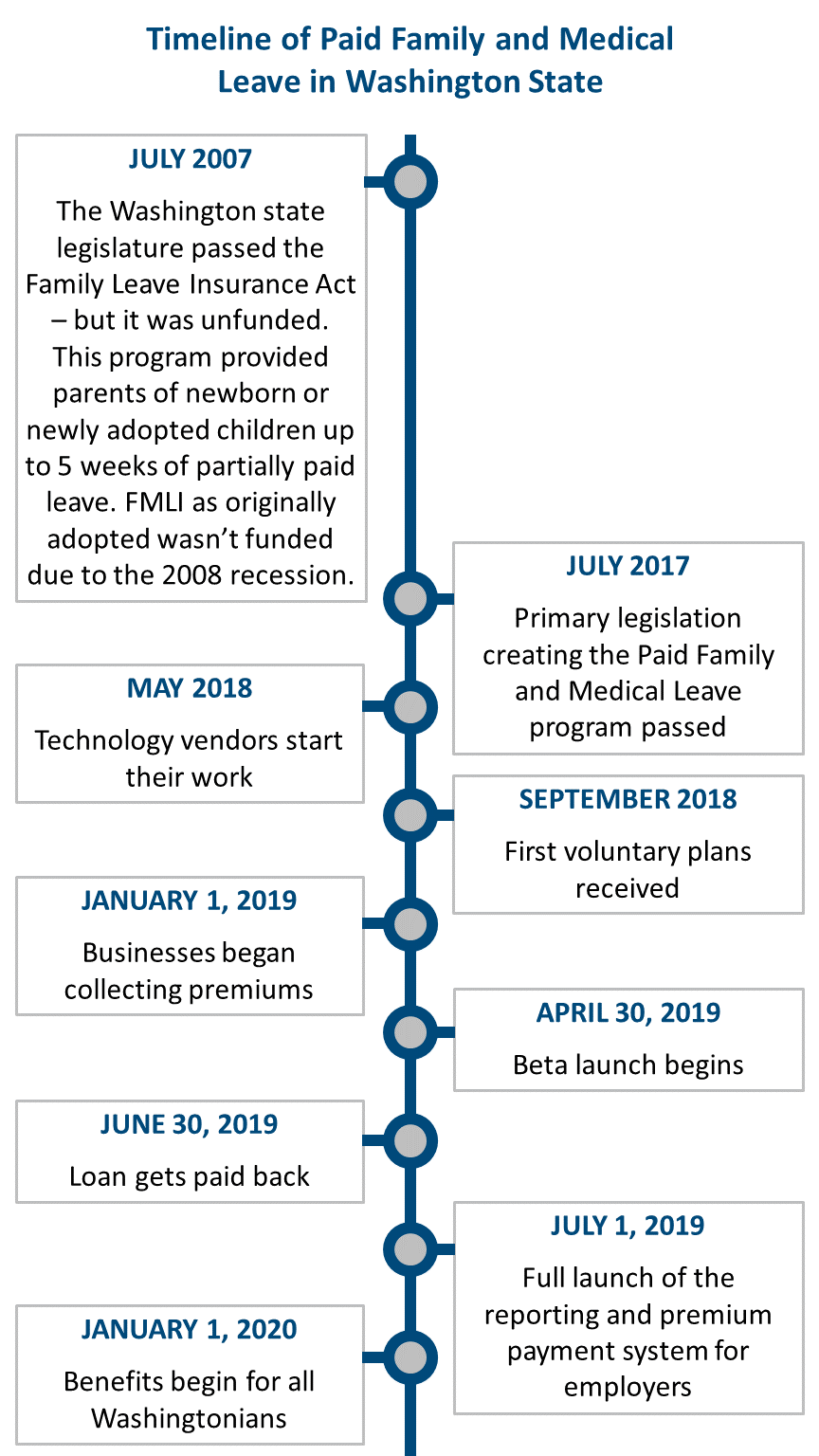This guest blog post is authored by Suzi LeVine, Commissioner of the Washington State Employment Security Department and former United States Ambassador to Switzerland and Liechtenstein.
I have a mom who is 81 years young, two teenage kids, a husband and two dogs. Starting January 1, 2020, I will also have access to the nation’s best Paid Family and Medical Leave program to help me take care of myself or any of those family members if needed (minus the four-footed ones!).
That’s because I live in Washington state, one of only five states in the nation to have launched a Paid Family and Medical Leave program, though a number of others are in the pipeline to launch or have recently passed legislation. This insurance program will allow workers to take up to 12 weeks, as needed, when they welcome a new child into their family, experience a serious illness or injury, need to take care of an ill or ailing relative and for certain military connected events. Up to 18 weeks is available in some cases. Paid Family and Medical Leave and the federal unpaid Family and Medical Leave Act (FMLA) mostly run concurrently, so workers who are eligible for 12 weeks of job protection under FMLA will receive it for Paid Family and Medical Leave, too.
More than family leave
While the family leave part of this program often gets the most attention, it is important to note that Paid Family and Medical Leave isn’t only for when someone welcomes a new family member into their lives or needs to care for a loved one.
The medical part of the program, in other states called temporary disability, means that leave can be taken for a worker’s own serious health condition like getting treatment for cancer or recovering from surgery. There are times for all of us when we need to give or receive care, so that means every Washingtonian will be able to use Paid Family and Medical Leave at some point in their life.
We are also particularly proud that this program will enhance the quality of life for our service members and their families. Military events, such as deployment and then spending time with an active duty family member pre- and post-deployment and during R&R, can be counted as events for which paid leave can be taken.
Benefits for employers and workers
I mentioned earlier this is the nation’s best Paid Family and Medical Leave program – this fact becomes apparent when you dive into the details of how it works for both employers and employees. The program is funded by a small premium, 0.4 percent of an employee’s gross wage, which is shared by both employers (37 percent) and their employees (63 percent). To qualify, an individual must work 820 hours in the previous 12 months before filing for leave. Self-employed individuals, including independent contractors, sole proprietors, partners and joint ventures, may opt in to the program to receive access to benefits.
Highly portable
These hours can be accrued across multiple employers, including part-time, seasonal and temporary work. Once the benefit has been earned it belongs to the individual and can be used at any time of the year, regardless of the employee’s work status or if they switch jobs. The portability of Washington’s Paid Family and Medical Leave benefit is important to workers across all income levels and is one of several critical components of Washington’s law other states are considering including in their programs.
Generous wage replacement
In fact, Washington’s program is quickly becoming a model for other states in many ways. We have one of the highest rates of wage replacement in the country, with workers getting up to 90 percent of their usual pay while out on leave. Wage reimbursement is also on a progressive scale, so lower income workers receive a greater share of their pay when they use Paid Family and Medical Leave.
Help for businesses
There are unique provisions to address the needs of small and medium-sized businesses, who often find it hard to provide this benefit to their employees due to the expense and the impact on their staffing. Available for medium-size business with 150 or fewer employees as well as for small businesses that choose to pay the employer share of the premium, business assistance grants of up to $3,000, ten times per year, help cover costs associated with an employee being out on leave, including paying overtime or the hiring of a temporary worker. When you consider that an employer pays roughly $1,470 per year in premiums on a $1 million payroll, the availability of grants of up to $3,000, up to ten times per year, is a significant business benefit. Small businesses under 50 employees are exempt from paying the employer share of the premium. However, they are eligible for the business assistance grants if they opt-in to pay the employer portion. This help for small employers means they can access a benefit to cover costs while supporting their staff and attracting and retaining talent.
Thoughtfully crafted

More than a decade in the making, this program was thoughtfully crafted by a bipartisan group of lawmakers as well as business and labor advocates. This collaboration is ongoing through the program’s Advisory Committee, which is made up of an even number of employer and employee representatives. This group is actively engaged in the rulemaking process and advising on other parts of the program’s development. To establish the program, legislators provided an $82 million loan that is due, with interest, June 30, 2019. After that point, the program will be self-funding.
We have made a substantial investment (4 percent of our budget) in outreach to businesses through trainings, webinars, advertising and public relations to ensure that employers are aware of this new program. The investment appears to be paying off, as 88 percent of businesses surveyed are aware of our Paid Family and Medical Leave program, and 53 percent of employers think this will have a positive or neutral effect on their business.
Washington’s Paid Family and Medical Leave program was developed to work for both employers and employees, and we are hopeful it will serve as the model for every other state and any future federal program. In addition to our department working individually with other states, we plan to help organize a summit to share and compare best practices as well as areas on which to improve.
With this program, all Washington state employers can better compete for and retain talent. This program also provides all Washingtonians the opportunity to take time to care for themselves and those they love, or to receive care from those who love them. We look forward to this spurring dialogue and action everywhere in the nation. Washington state’s advantage should be everyone’s advantage.


